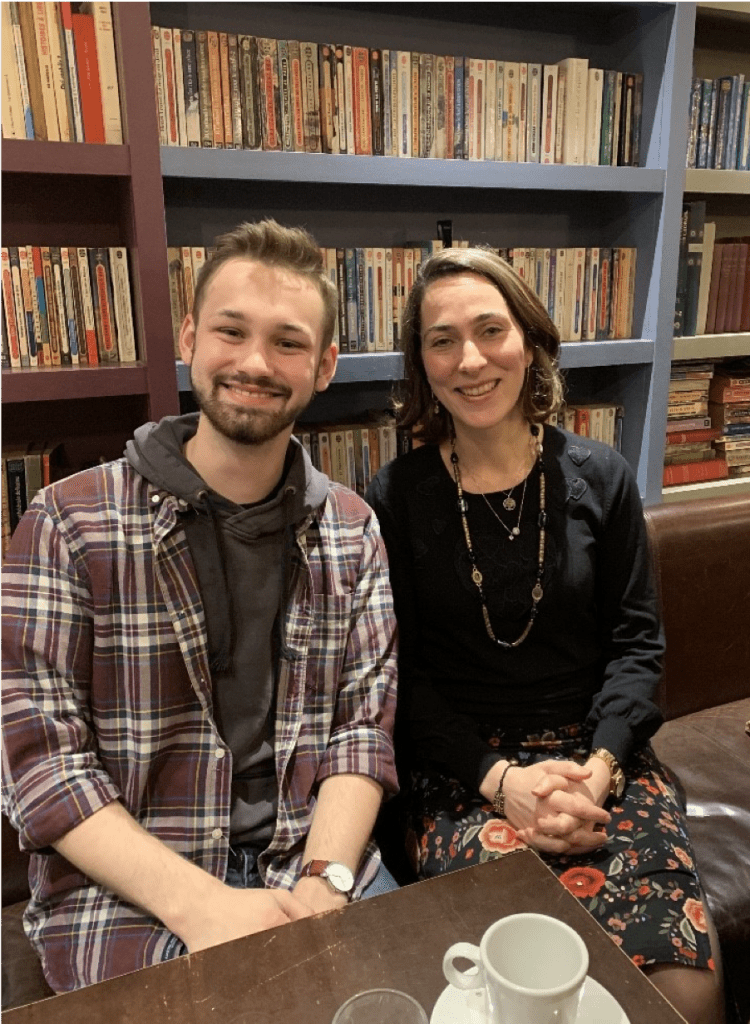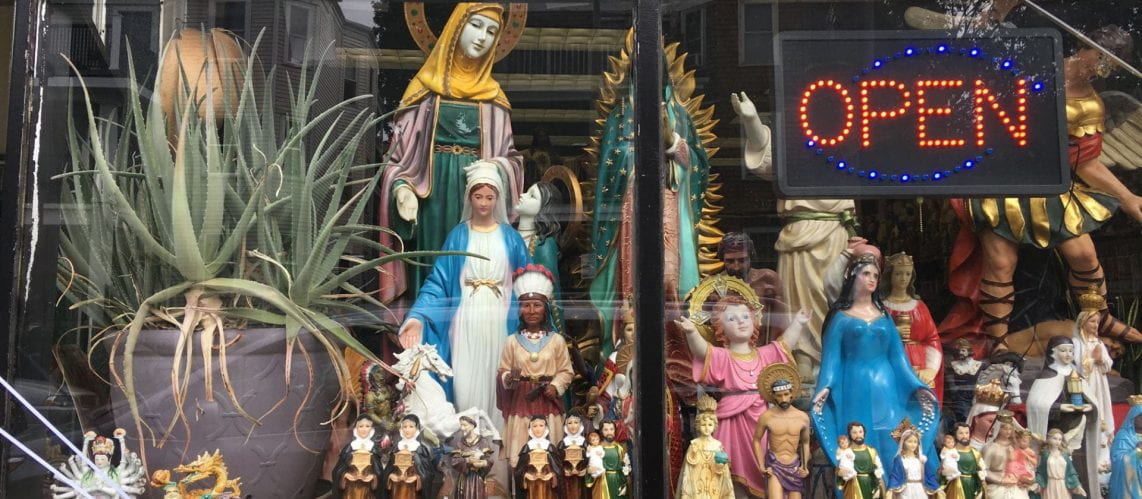Mitchell Rutledge
Mitchell Rutledge is a graduate of Prospect High School in Mount Prospect Illinois, where he was a student of Religious Literacy Project Education Fellow John Camardella. He is currently an undergraduate student at the American University of Paris.

Throwing open the front door—no shoes, no socks, no care—I sprinted down the stone stairs of my Parisian apartment building. Holding on to the railing to ensure safety, I descended to the second floor. Arriving, I knocked on the wooden, stained door waiting for one of the girls to open. Finally, Gisele slowly pulled it back with the skeptical demeanor she often greets me with. I burst in joyfully, shouting to Briana who is sitting on the all-too-familiar red, oddly stained couch near the window. “You will never believe who just texted me!” Briana, knowing I had been working on the project for six months, had known before I even knocked on the door. “Kahina!” she responded.
Kahina Bahloul, the leading woman imam in France is someone I had learned about in my high school religious studies class. We had read the New York Times article by Doreen Carvajal titled, “Finding a Place in Women’s Mosque,” which thoroughly outlined Ms. Bahloul’s and Mr. Korchane’s work in Paris; however, it left me wondering. Where were they at in their project since its publication? How do they perceive Islam in a global sense? What has shaped their ideology and beliefs, etc.? Therefore, after moving to Paris, I set out to get answers to my questions. Before divulging what would come of this search, however, I must address how I got to this point in my life.
Since a young age, I had continually gained knowledge of religions and cultures from personal research and self-interest. Luckily, my parents—being open-minded Christian pastors—allowed me to explore new religions, the diversity found within them, and the cultures they are embedded in. My fascination with religion originated from the way the theology of Methodism related to my sexuality. I critically examined how Christianity developed, coming to find that the religion was internally diverse and culturally embedded; however, I did not have the language to express this until my senior year of high school. John Camardella’s class, which used the Religious Literacy Project’s method and resources, opened my eyes and mind to a new way of engaging with religion and culture.
The classroom that the RLP created was one where all students were engaged and interested in the topics being taught. Rather than being lectured at, the students were encouraged to explore new ideas, ask questions, and critically examine how religion fits into the three assertions concerning the study of religion in a non-devotional sense: cultural embeddedness, evolution and change over time, and internal diversity. By being able to study religion through a cultural lens, students were able to observe that these assertions were true and gain valuable knowledge of a range of cultures. For instance, many in the class were unaware that Sikhism is a religion that most men wear turbans. This lack of information in 2001 led many to confuse Sikh men for Muslim men, subjecting them to harassment, violence, and murder. If the Cultural Studies Method provided to me would have been implemented much earlier throughout the United States, misconceptions of both Sikhs and Muslims could possibly have been avoided. Misconceptions such as these are what led me to become extremely interested in the Fatima Project and Kahina Bahloul.
Surprisingly, I had already been considering attending university in Paris when we were reading the New York Times article. Once committed to the American University of Paris, I was set on contacting Ms. Bahloul and her Partner Faker Korchane. My intent being to author a story about the two of them and their project. I believed that this would be the best way for me to not only answer my lingering questions but share the answers to a wider community. After taking the World Religions class my senior year, it would be interestingly thrilling to apply my knowledge to a real-life situation. Mr. Camardella, my teacher, and the Religious Literacy Project at Harvard Divinity School had equipped me for this moment. A moment where I would apply my high school education to the real world.
Four months after moving to Paris and searching, I was in contact with Mr. Korchane. He generously invited me to his meeting of the organization of Mu’tazila Paris and coffee afterward. I graciously accepted such an honor and scheduled to attend the coming Saturday. When the day arrived, I got into the Uber and rode for 30 minutes across Paris to the addresses he had sent me: 4 Rue Oberkampf. I do not know what I was expecting. Maybe nothing. But I got out of the Uber and found a bookstore with the number 4 plastered above it. I walked in and found a diverse group of people talking. The meeting began, and I listened to their inquiries, debates, and answers coming to see the diversity of Islam and the way it had become embedded in the French culture. This group came to accept me and excitingly supported my interest in their beliefs. Soon after the meeting had ended and we had sipped our final drip of coffee, I asked Mr. Korchane with help contacting Ms. Bahloul. He agreed.
Two weeks after our meeting, Mr. Korchane messaged me saying that he would be with Ms. Bahloul the coming weekend, and they would be able to possibly FaceTime. I overfilled with joy. Saturday came, and I sat inside all day. Waiting. Anticipating my phone would soon ring. The day dragged on and soon began to descend into the night. The sun began to set, and time was running out. Then, my phone went off: a text from Mr. Korchane. “Sorry Mitchell I’m late: This is her number.”
I texted Ms. Bahloul immediately, after thanking Mr. Korchane, asking to meet or FaceTime. I waited. Nothing came, and I soon went to bed. The next morning, I woke up and found a text from Ms. Bahloul: “Bonjour Mitchell, Je vous propose un rdv.”
This is the part where I leaped from my bed, threw open my front door, and sprinted down the stairs. She wanted to meet me! I had been searching for six months. Finally! Time to utilize the skills I had gained in high school. She proposed meeting at a café housed in my favorite part of Paris: Le Marais. I prepared my questions and asked my classmate Alayna to come with me to help translate if needed. I knew her French was impeccable. The day came and we got into the Uber— I was too nerve racked to take the eccentric Parisian Metro. We arrived and got a table for three in the back. We waited and watched. Soon enough, she arrived and spotted us.
We greeted each other with grandiose smiles, mine being unable to control. Alayna waved down the waitress, and we placed our order. I began asking the questions which had been accumulating for months in my head. She answered each one with much detail, respect, and honesty. Through each question, I was able to see how religion was embedded within the multitude of cultures she was speaking of, changed over her lifetime, and was internally diverse within her numerous experiences and understandings.
The RLP’s method was not only being utilized by me but confirmed by Ms. Bahloul. She and I had a lengthy conversation which was intellectually enriching as we delved into the situated circumstances of her life and the Fatima Project. To conclude the meeting, I asked her one final question: “If you were in front of the class I was sitting in a year ago where I had read about you what would you say?” Her response was invaluable: “To show you that Islam is not one dimensional.” It was truth that I had been taught by the RLP.
Harvard’s Religious Literacy Project and the numerous high schools around the United States which have drawn from its work have begun implementing a new curriculum. A curriculum that is all-encompassing. A curriculum that is inspiring. A curriculum that will change the lives of the students who learn from it. I know this for a fact. I know because it changed mine.

